In the closing stages of the Premier League, Manchester United welcomed Chelsea in a direct battle for the Champions League spots. Solskjær’s team tried to get out of their negative form and return the good atmosphere by winning against their biggest competitors in the race for a place in Europe’s best club competition next season.
The Blues wanted to keep going down the “Sarriball” route and to continue with their progress under the Italian manager, but United’s approach kept them from three points in this game. In this tactical analysis, you will see how both teams failed to perform under pressure and how every single one of their pre-game plans fell apart due to bad on-field implementation.
Line-ups
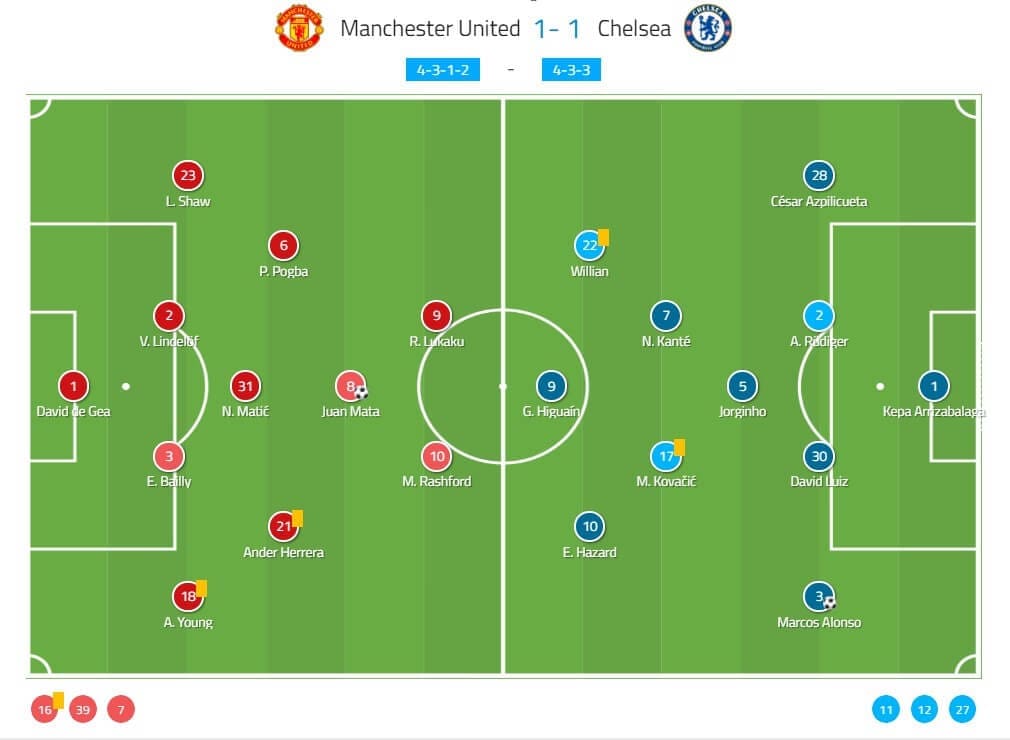
The home team started the game with their strongest squad using the 4-1-2-1-2 formation with Romelu Lukaku and Marcus Rashford at the top of it. They tried to override Chelsea’s midfield numerically with four players in that line of the team and Juan Mata as a main creative force. Herrera and Pogba provided width and support.
The team from London went into the game in their usual 4-3-3 formation with no big surprises. Their attacks once again depended mostly on Eden Hazard’s creativity, and fluidity of the ball organised by Jorginho. Mateo Kovačić started the game instead of Ruben Loftus-Cheek in order to bring more discipline to the team when in defence.
Manchester United’s high pressing disables “Sarriball”
Solskjær’s boys went into the game with only one goal – to prevent Chelsea’s good passing game from happening. They had a pretty clear approach since they tried to press their opponent’s high and to narrow the pitch for them right from the first minute.
Chelsea once again struggled to break the high pressing, lacking good options to progress through the lines due to bad positioning of their midfielders and good man-marking by United’s players. Herrera, Mata and Pogba did a fine job guarding Jorginho and Kovačić, and that made Chelsea try with longer balls but with little success.
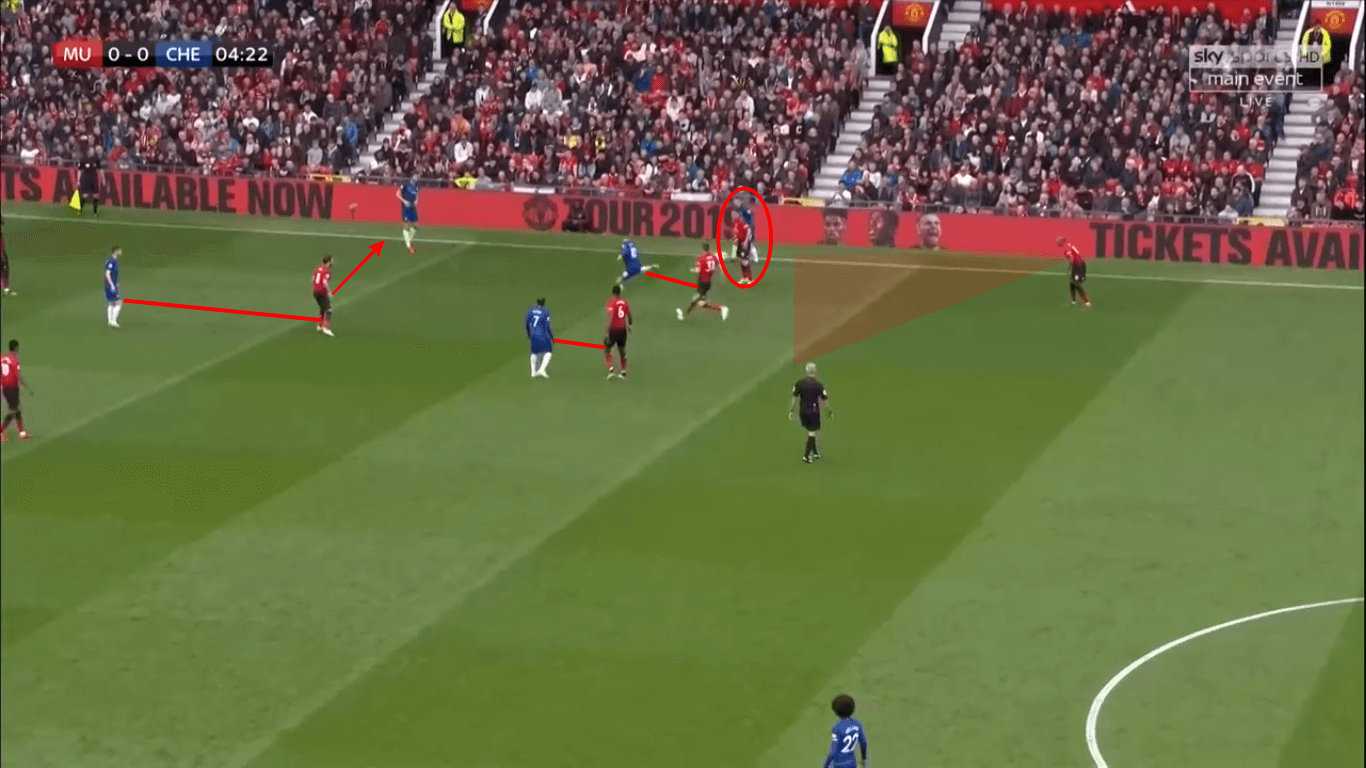
As we can see on the picture above, the home team managed to cut the in-depth lanes for passing and brought their opponents in a bad position for the attack to progress. They oriented their press to the flanks targeting Luke Shaw and Ashley Young as the opposition’s weakest links.
United tended to win the ball back right after losing it so that made them become very aggressive and play a well-organised counter-pressing game. Both Lukaku and Rashford played a huge role in those situations, forcing Chelsea’s defenders to pass to the flanks or to go with the long ball.
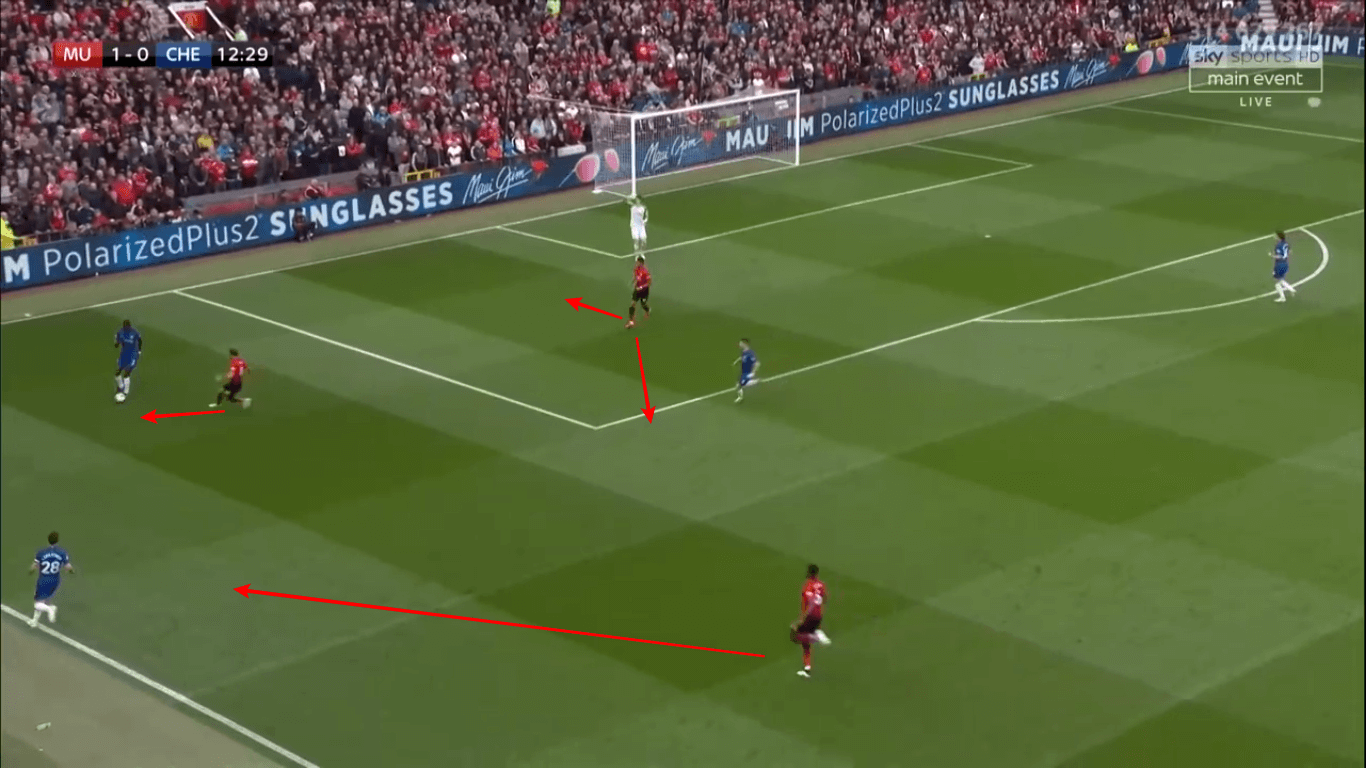
The Red Devils positioned themselves very high up the pitch and disabled “Sarriball” from the beginning. They man-marked opposition’s players who were in charge of the build-up and succeeded in winning the ball in dangerous zones.
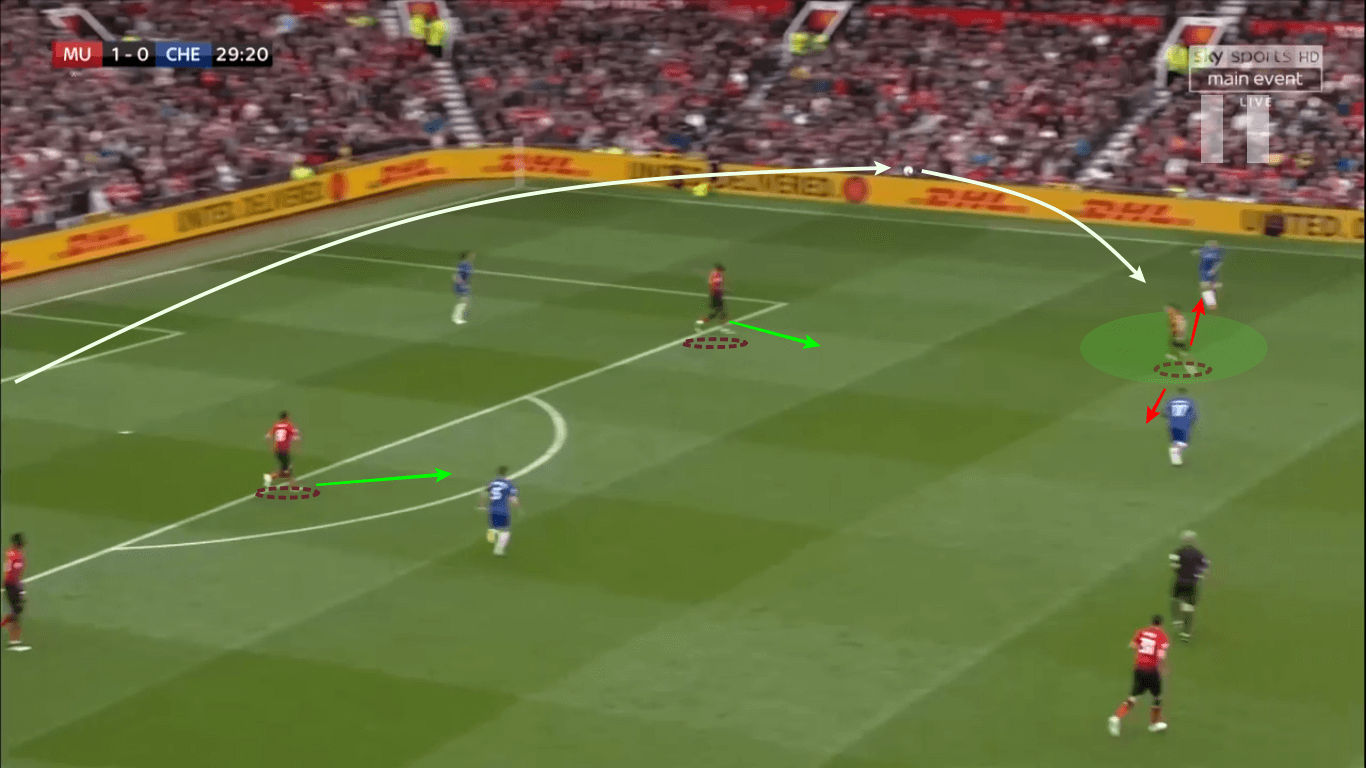
That type of play forced Kepa to go with more difficult solutions, leading to a few misplaced long passes from the goalkeeper which United could use to threaten his goal.
Solskjær widens the pitch and lowers the strikers
Manchester United were the team that started the game better. With all of the high pressing and determination they had, they dominated the pitch for most of the first half. Since they had numerical superiority in the middle, Solskjær’s boys tried to exploit it and to create chances thanks to that fact.
Pogba and Herrera were the keys to the Norwegian’s idea. The midfielders positioned themselves on the flanks, asking for the ball, and for the full-back to guard them which created a gap of free space behind Azpilicueta and Alonso.
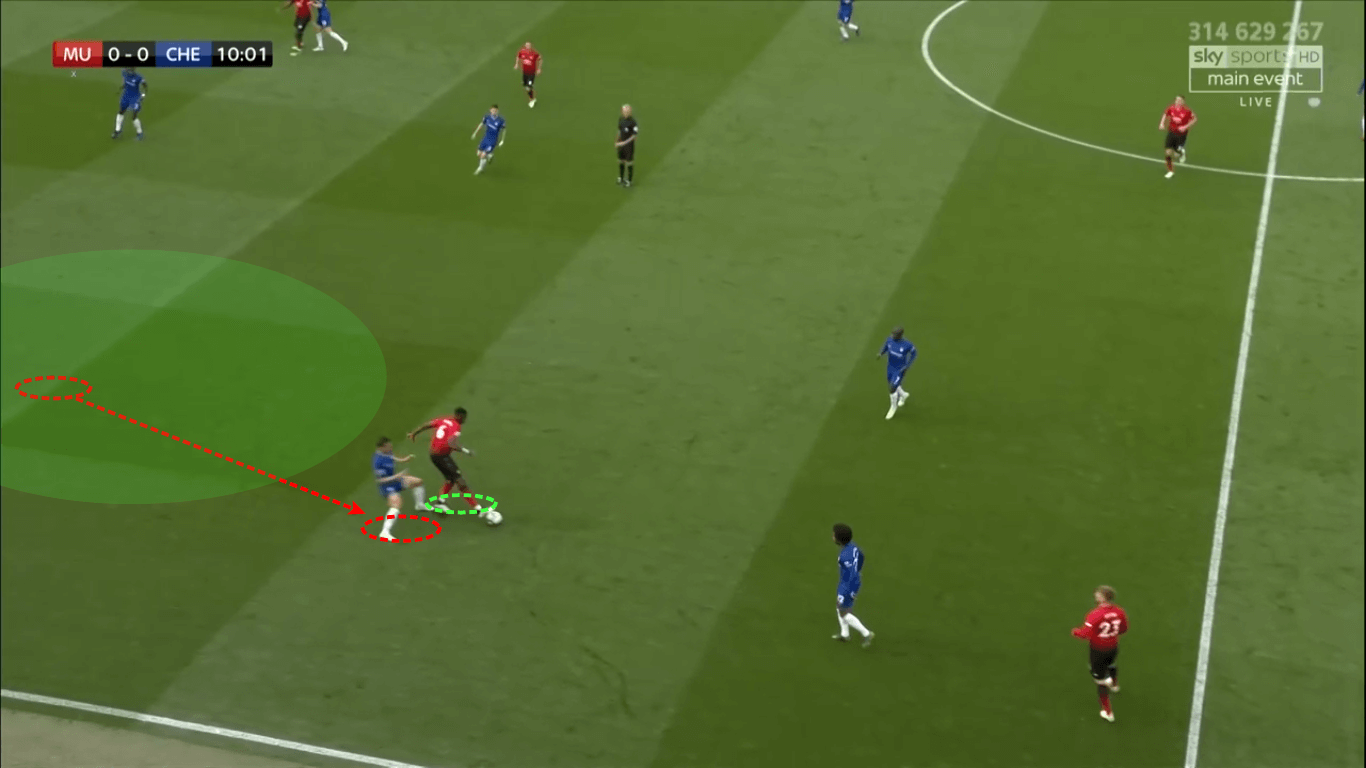
Chelsea’s defenders had some issues in the communication and that made it possible for Manchester United’s strikers to use the space that was left free between the defenders on the sides. Both of the attackers exploited those spaces drawing themselves to the flanks and getting the balls in those situations.
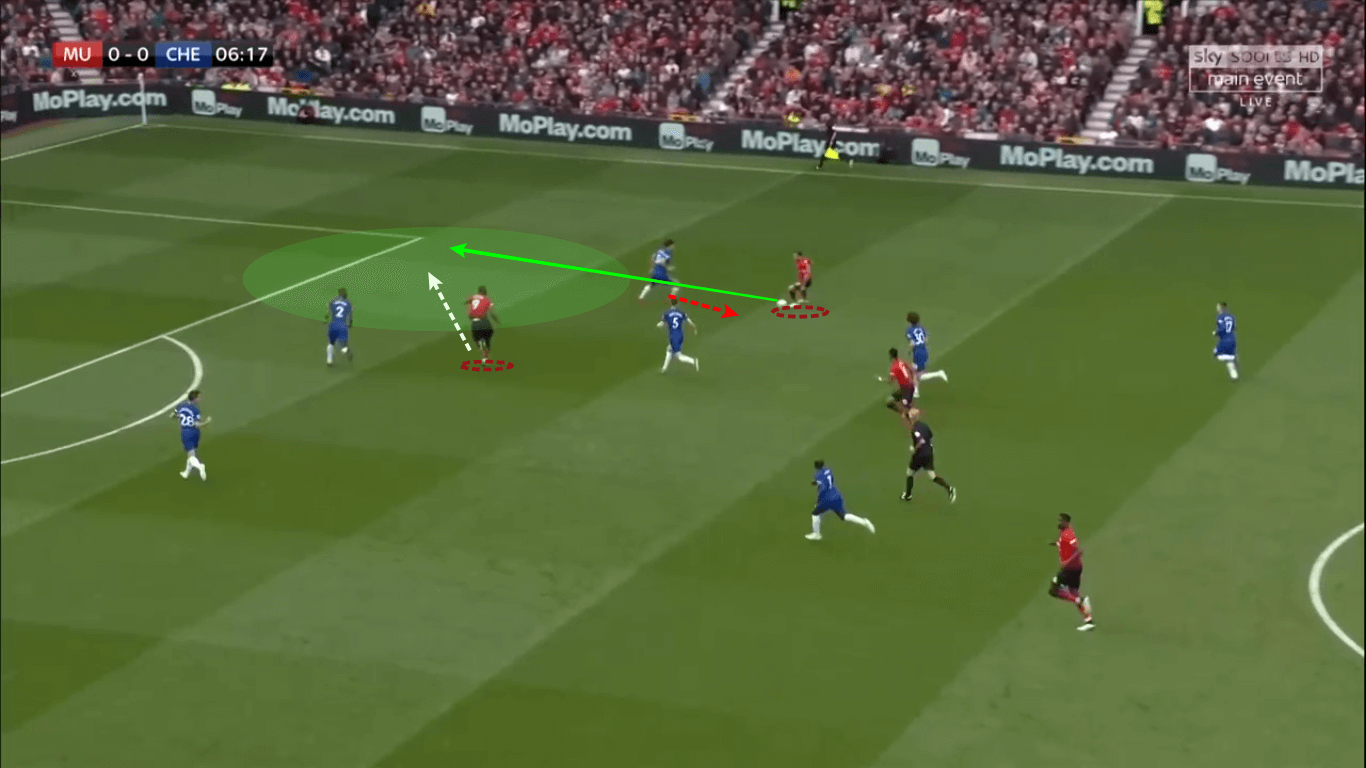
Sarri‘s team had big problems with the opposition’s high press which lead to issues with the team’s organisation. Their defensive structure suffered due to a bad transformation and enabled Lukaku to get the better of them by dropping off and finding gaps in the half-spaces between the lines.
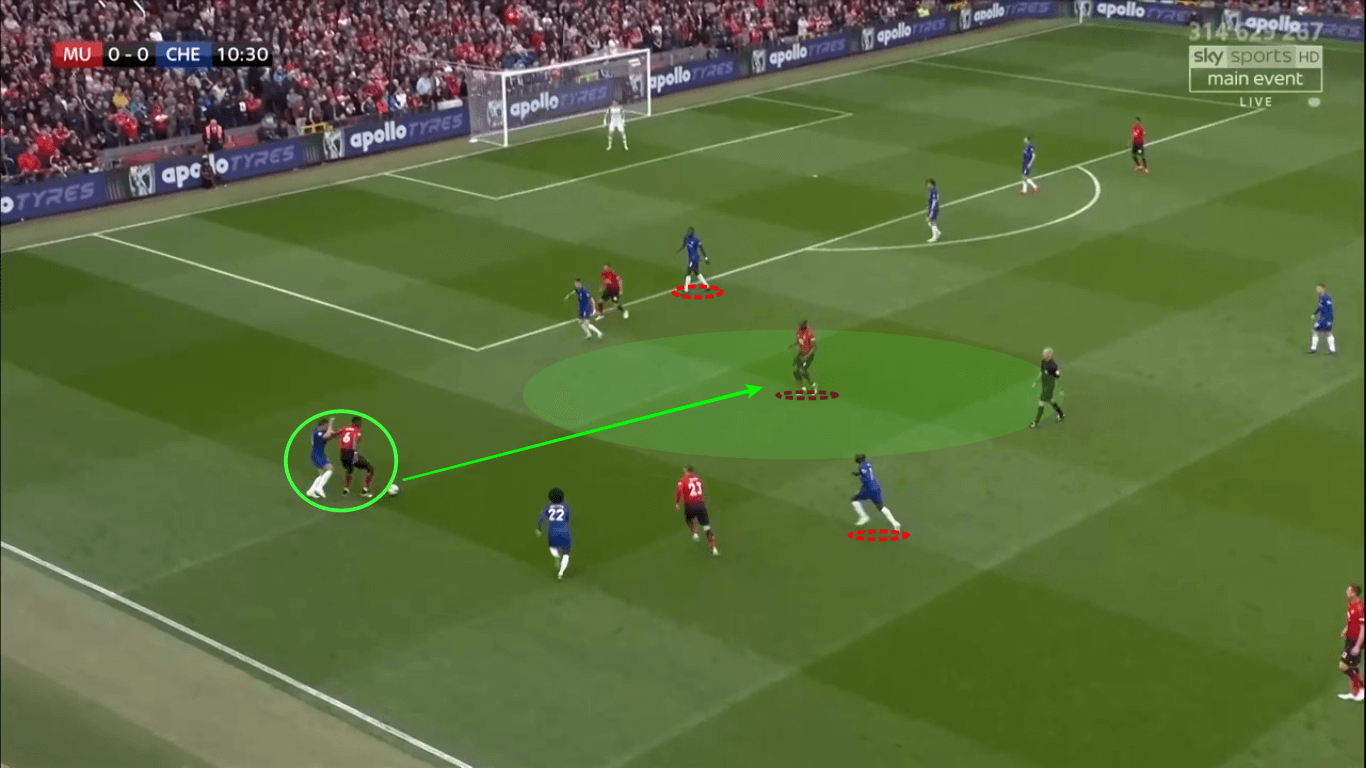
One of those situations paid off for the home team and they got the advantage from the Belgian’s great positioning and decisive pass to Shaw. The 6 foot 3 striker put Chelsea’s defenders in big trouble with his movement and great spatial awareness from which he created good opportunities for his team-mates.
Chelsea’s rotation
The Blues tried to get into the game in the second half since they didn’t manage to play the way they wanted in the first 45 minutes. They relaxed a bit and went easier through the opponents’ lines, although Manchester United continued with their high press.
Jorginho found a way to position himself better and was the key to breaking through the first pressing line. Chelsea became dangerous due to their good rotations in the opposition’s half of the pitch. Higuaín dropped deeper in order to create space for his midfielders and that confused the home team’s defenders when it came to guarding opponents.
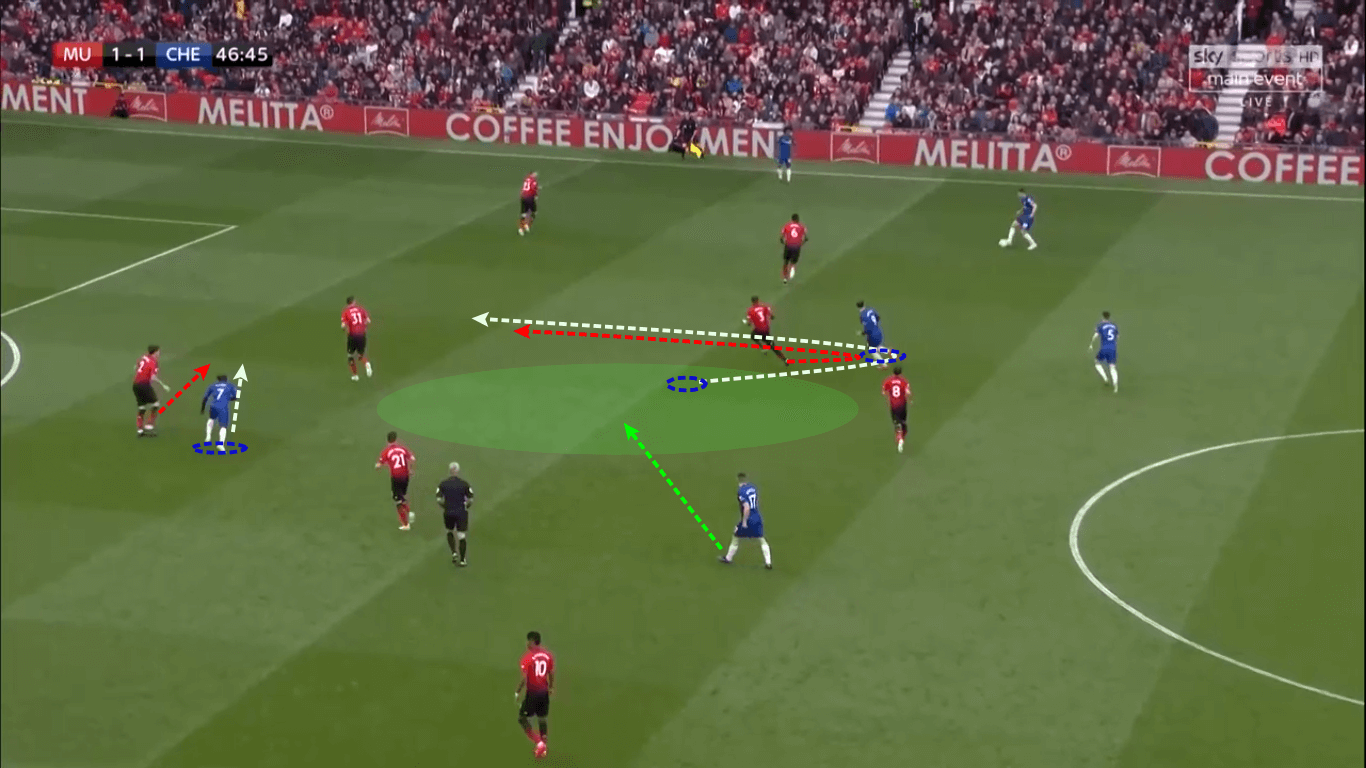
In the picture, we can see Higuaín pulling himself out of his position and dragging Bailly with him, in turn disrupting Manchester United’s defensive organisation. Kanté ran into the space which was left by the Argentinean striker who faked his other movement so Kovačić could get the ball through the gap between the lines.
Chelsea tended to confuse defenders and create free room for their midfielders. Their number nine was the main man for that to work because he did a pretty good job of engaging Bailly and deceiving him with his false movements.
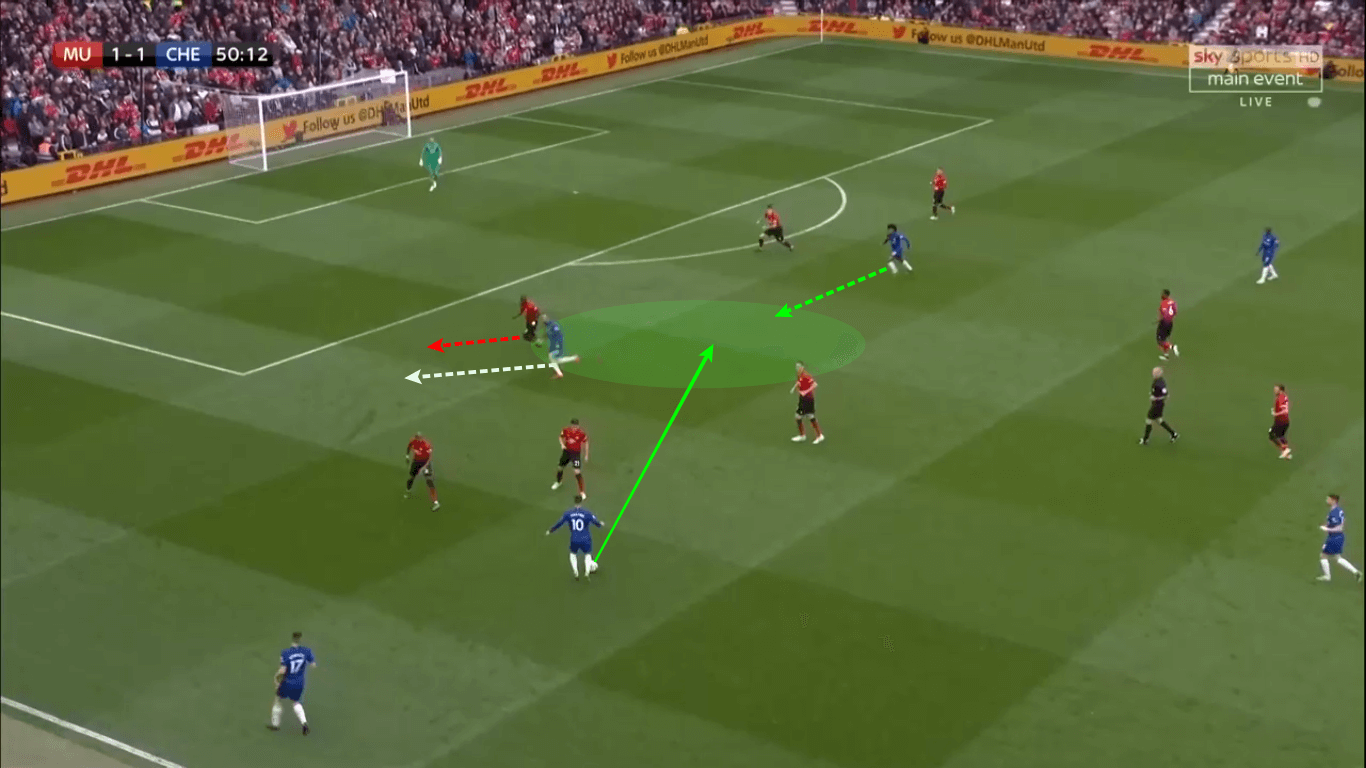
He dragged the Ivorian defender with him even in situations in which he wasn’t a good option for passing. Higuaín relied on the naivety of Bailly and exploited it to create free room for his teammates (mostly Hazard and Willian).
Chelsea’s main attacking force once again was Eden Hazard. Their best player made good positions out of bad ones and enabled his team to go forward in dead-end situations. He also succeeded to find gaps when United’s block was well-organised and produced opportunities due to his individual quality.
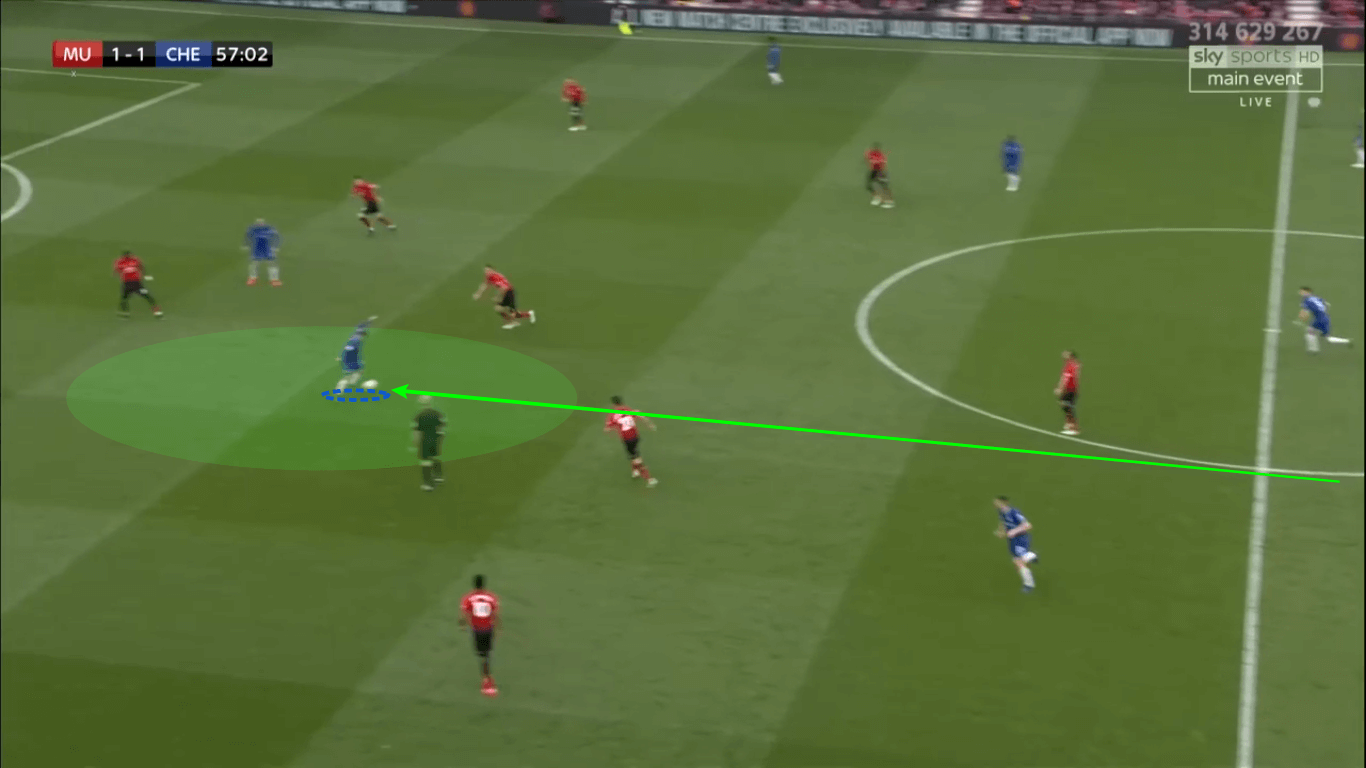
Hazard managed to make use of very small gaps and got the ball through two opposition lines a few times during the game. He and the other two attackers constantly rotated with their midfielders in order to create a mix-up in the home team’s defence. Even though they succeeded in creating spaces, they weren’t good enough in the final third so they had to settle with just one point out of this match.
Conclusion
Both teams struggled to live up to their pre-match plans since their players haven’t been concentrated enough to accomplish all of the tasks set by their managers. Manchester United started the game much better than their opponents and they were a better side throughout the first half of the match, disabling “Sarriball” with their high press and creating spaces on the flanks with midfield movements.
Chelsea succeeded in getting into the game more in the second half but didn’t manage to go all the way to play in the manner their Italian coach wanted them to. Hazard’s individual quality wasn’t enough for them to overturn the result in their favour, and the battle for the Champions League spots is still going with full steam and as interesting as it was before this match.
If you love tactical analysis, then you’ll love the digital magazines from totalfootballanalysis.com – a guaranteed 100+ pages of pure tactical analysis covering topics from the Premier League, Serie A, La Liga, Bundesliga and many, many more. Buy your copy of the April issue for just ₤4.99 here, or even better sign up for a ₤50 annual membership (12 monthly issues plus the annual review) right here.

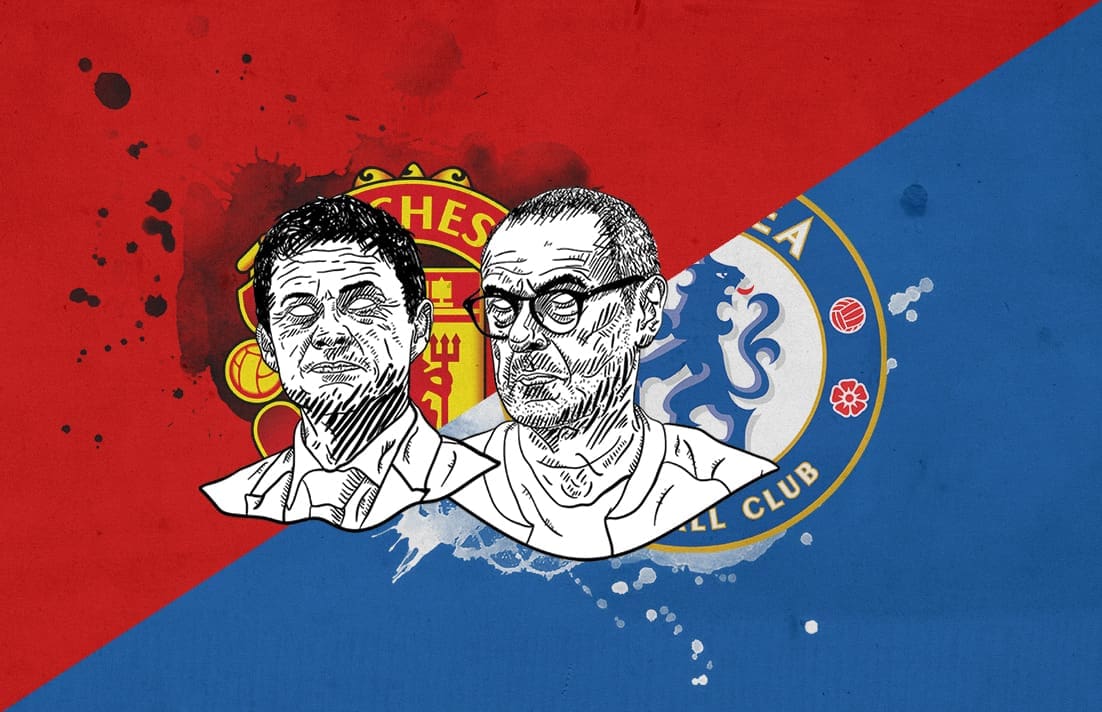



Comments